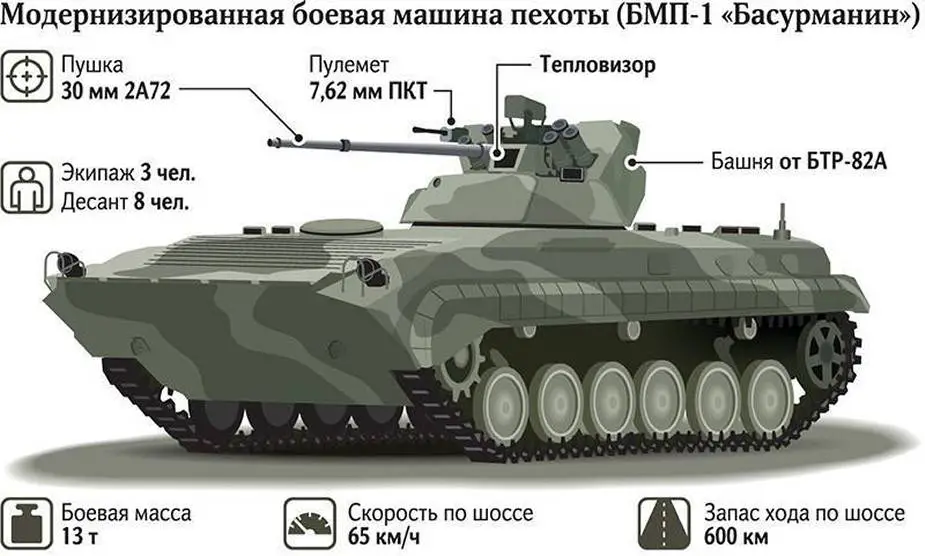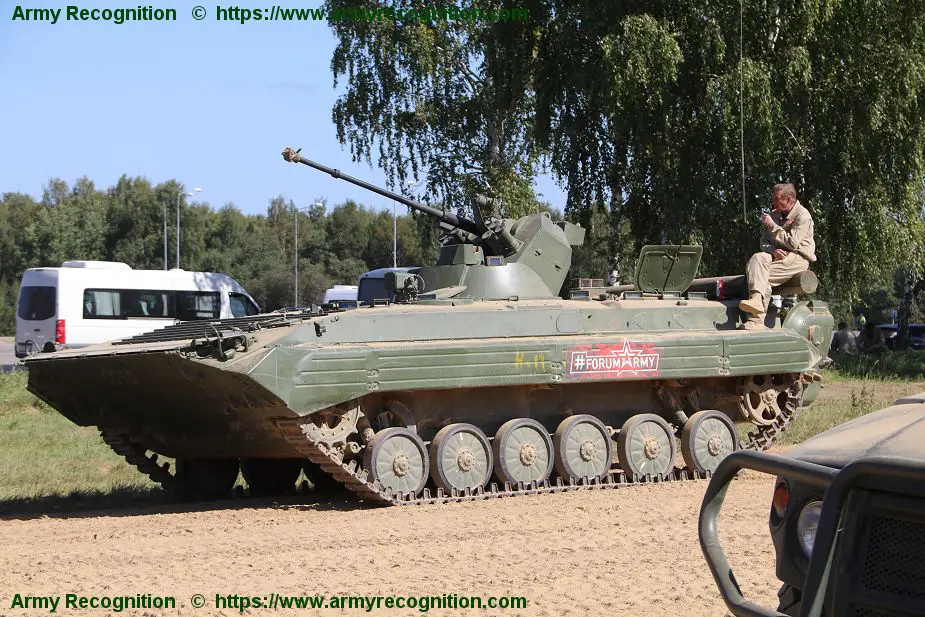Breaking news
Russian army to receive modernized BMP-1AM Basurmanin IFVs.
A large batch of modernized BMP-1AM Basurmanin infantry fighting vehicles will go into service with motorized rifle units of one of the combined arms armies of the Eastern Military District. This was reported by the press service of the Russian Ministry of Defense.
Follow Army Recognition on Google News at this link

BMP-1AM Basurmanin unveiled at Army 2018 defense forum near Kubinka (Picture source: Army Recognition)
The upgraded BMP-1AM "Basurmanin" will go into service with the motorized rifle unit stationed in the Jewish Autonomous Region in the first half of February. The number of vehicles is not reported, but it is noted that the batch will be large. In the units, the new infantry fighting vehicles will replace the already outdated BMP-1, which is currently in service with motorized riflemen.
As emphasized in the press service, the BMP-1AM version is considered one of the best options for upgrading the BMP-1. The BMP-1AM was first shown in 2018. In the same year, Uralvagonzavod announced the development of a large-scale modernization program for the existing BMP-1 fleet to the BMP-1AM level. According to open sources, the units and formations of the Russian army have several hundred BMP-1s, and several thousand more are in storage.
In the West, Novosti writes, the BMP-1AM was called the "budget replacement" for the BMP-3 infantry fighting vehicle. The outdated 73mm gun "Thunder", which no longer meets modern requirements for combating NATO military equipment, is being replaced by new weapons.
During the modernization of the BMP-1 to the version of the BMP-1AM "Basurmanin", the vehicle receives a unified fighting compartment from the BTR-82A with a 30mm 2A72 automatic cannon, a 7.62mm PKTM machine gun. The BMP is equipped with a fire control system with a combined all-day anti-aircraft sight TKN-4GA-01, a two-plane weapon stabilizer and anti-tank guided weapons ATGM 9K115 "Metis". In addition, the UTD-20S1 engine and torsion shafts of increased energy intensity are installed on the new BMP.

BMP-1AM (Drawing source: via Novosti)
The BMP-1AM retains the size, except for the height. It became 1.5 meters taller(2,550 mm). The crew strength (three men) and the assault team (eight soldiers) remain unchanged. The basic UTD-20 engine has been replaced by economical UTD-20S1 (as in the BMP-2) with the same 300 HP power. The total weight increases to 14.2 tons, but the maximum road speed (65 km/h) and the range (550 km) remain the same.
The old R-123M radio equipment has been replaced by the modern R-168-25U-2 of the Akveduk digital system, which provides sustainable and protected communications.
The turret with its 73mm smooth-barrel Grom 2A28 gun has been replaced by a combat module with 30mm automatic 2A72 gun stabilized in two axes. Grom possessed good characteristics for its time and could destroy fortifications in the battlefield, including bunkers. PG-15V projectile with cumulative PG-98 grenade could destroy a tank. However, NATO hardware has now received multilayered distributed armor with enhanced cumulative protection.
Grom has a slow initial projectile speed and fire density and the small turret limits the guidance angles, mostly the vertical one. The stocks of projectiles have been exhausted and there is no sense to resume the production of projectiles fired only by BMP-1 and SPG-9 grenade launcher. The rearmament with a 30mm gun became necessary to ensure unification and munitions.
BMP-1AM is now equal in firepower to BTR-82A and BMP-2. The modern combat module provides a better view for the commander and pointer. New fire controls with a night sight ensure precision fire. The maximum elevation angle increased to 74 degrees and the vehicle can fire at ground and air targets and effectively operate in urban combat when it is necessary to fire at top floors. Metis 9K115 antitank missile system is used to fight armored targets.
BMP-1AM for the first time appeared in public at Alabino range during the Army forum in 2018. Organizers also called it Basurmanin and experts concluded it was intended mostly for export. They believed the main markets were in the Middle and Near East. They have received several thousand BMP-s1 and many are still operational. The plant in Chelyabinsk produced over 20,000 vehicles from 1966 and two-thirds of them were exported.
Experts criticize Basurmanin for low protection and mobility, as well as modest antitank capabilities. Additional appliqué perimeter armor similar to what is fitted on the BMP-2M can decrease vulnerability. However, it will further decrease mobility. It can be radically increased by the new supercharged UTD-23 diesel engine of 400 HP which thus develops 100 HP more than an ordinary UTD-20 can provide. Industry representatives sometimes speak about a more powerful power plant for the BMP-1AM, but there is no confirmation about such a decision of the customer.
Enhanced engine and gearbox are the main requirements of the Indian army to the upgrade of its Russian BMP fleet. They are necessary because of a hot climate and mountain operations. If the foreign customer pays for the upgrade, it will be an additional stimulus for the Russian military.
Enhanced antitank weapons have been an issue since Soviet time. Initially, the BMP-1 was armed with Malyutka missiles and then with Fagot from 1979. Upgraded options offered MB2 combat compartment with Konkursk antitank missiles (Muromteplovoz) and Clever or Bereg module with Kornet missiles (KBP). The latter has a digital automatic fire control with various sensors (including heat imagers) to destroy targets day and night from a 30mm gun and by guided antitank missiles at a distance of 8 km.
The main problems of additional armor, new engine and missiles are their financial cost, incomparable with the residual value of the BMP-1. The infantry fighting vehicle was designed to transport soldiers cross-country or by road to the mission area and provide fire support. The fifty-year-old Soviet military doctrine staked on the large-scale offensive of tank and motorized rifle formations with massive aviation and artillery support. Numerous BMP-1s had to operate along with tanks. Motorized rifles had to disembark several hundred meters before the frontline and operate under the protection of machinegun and gunfire of armored vehicles.

BMP-1AM unveiled at Army 2018 defense forum near Kubinka (Picture source: Army Recognition)


























